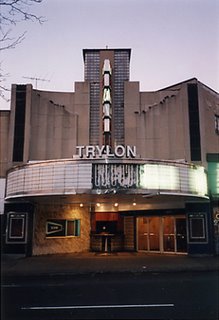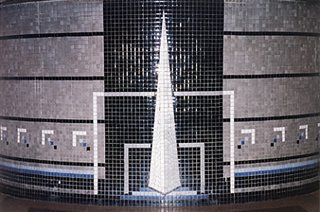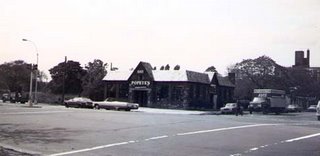FOREST HILLS TENNIS STADIUM--1 Tennis Place (off Burns Street, north of 71st Avenue), Forest Hills, Queens. Founded in 1892, the West Side Tennis Club operated at several inadequate Manhattan locations over a twenty-year period before planting permanent roots in then-pastoral Forest Hills. The well-appointed new club, opened in 1913, became so highly regarded that the U.S. Lawn Tennis Association decided to hold its National Championship there two years later. These games--later renamed the U.S. Open--continued to be held annually at West Side until 1978 (whereupon they were moved to Louis Armstrong Stadium in Flushing). To accomodate spectators, a 14,000-seat stadium (some reports say 15,000) was built on the grounds in 1923. For highlights of the site's role in tennis history, check out these links.
Ron Delsener is given credit for establishing the stadium as a music venue. According to an article in the Wharton Journal, he came up with the idea one summer while employed there (presumably in a non-musical capacity) in the early '60s: "You didn't have to pay for heat or air-conditioning. Kids were out of school. And with the exception of the Hollywood Bowl and maybe one or two other places, no one else was doing this [outdoor pop-music concerts]." The earliest concert dates I've found are the Kingston Trio on August 5, 1960, Judy Garland on July 1, 1961, and Joan Baez on August 17, 1963 (at which Bob Dylan joined her for a couple of numbers). There must have been other early '60s shows, but it seems like the ball really got rolling over the summer of '64.
Put aside whatever personal vendetta you may have against Barbra Streisand for a sec (I dig her, OK?) and check out this page documenting her FHTS appearances on July 12, 1964 and August 8, 1965. You'll see a couple of ads for the Forest Hills Music Festival, as the summer concert series was then dubbed. In addition to Barbra, the '64 ad lists the following shows (most dates are difficult to read): Trini Lopez, Count Basie and Woody Allen (stand-up, not clarinet); Harry Belafonte and Miriam Makeba; Joan Baez (August 8; Dylan again sang with her for part of the set); Johnny Mathis; and, in the ultimate '64 booking coup, the Beatles on August 28-29. The '65 ad is much harder to decipher, but I can make out the likenesses of Peter, Paul & Mary, Judy Garland, Count Basie, Frank Sinatra, and Barbra and Woody again, among others. One Forest Hills resident on cinematreasures.org remembers the era fondly: "Besides the US Open playing 3 blocks from my house, the Forest Hills Tennis Stadium once played incredible concerts. The summer of '64 must have had the most star studded lineup ever. Sinatra played with Count Basie. There was Judy Garland, Barbra Streisand, Louis Armstrong, Peggy Lee and Chet Baker to name a few. And lets not forget the Beatles who caused so much mania they landed in a helicopter on the courts of the West Side Tennis club. My folks took home movies of the mobs packing Burns Street all the way to Continental Avenue. The other great thing was you could hear the shows from the Street if you could not get tickets."
The Beatles' dates were their first New York appearances since Ed Sullivan and Carnegie Hall in February '64. Leslie West offers some memories of the show, and of growing up in Forest Hills, here. During the afterparty at the Hotel Delmonico on that first night, Al Aronowitz introduced the lads to Bob Dylan--who in turn introduced them to the demon weed, according to legend (though I've always found it hard to believe they hadn't already encountered pot in tough Liverpool or the wild Reeperbahn).
[UPDATE 8/25/2010: Read Binky Philips' fab memories of this show here.]
Speaking of Dylan, his August 28, 1965 FHTS date is almost as notorious as the Newport "goes electric" appearance a month previous--and probably received an even more hostile crowd reaction. Al Kooper gives a great account in his Backstage Passes and Backstabbing Bastards (New York: Billboard, 1998). It's too lengthy for me to quote here, but he summed it up well in No Direction Home--to wit, the crowd basically booed, heckled, and cussed all through the electric portion of the show, stopped to sing along with "Like a Rolling Stone" (#1 on the charts that very week), then continued to boo afterwards. Eyewitness reports and photos are available at these links. I'm assuming this pic was taken at the soundcheck.

As if seeking to complete some kind of Ultimate Sixties Band trifecta, the Rolling Stones played FHTS on July 2, 1966. Enjoy these fan reminiscences--one notes that
[UPDATE 5/25/2010: The Life archives have about three pages of fab fotos from the show!]
[UPDATE 4/2/2012: Why yes, I was indeed thrilled to have this show play a major part in Mad Men episode 503, "Tea Leaves"!!! The Trade Winds connection was a completely new factoid to me...and the reference to a sack of 20 from the White Castle on Queens Boulevard was a killer touch. A color poster for the '66 summer show lineup appears here, and here's a setlist.]
[UPDATE 4/6/2012: Mad Men fansite Basket of Kisses did a post about the '66 Stones tour, and Gothamist also did a post on the FHTS Stones show. I just started reading Johnny Ramone's memoirs, and his ticket to this show is reproduced in the book.]

This terrific ad lists the rest of that summer's line-up:
- Sammy Davis Jr. and the Count Basie Orchestra, with Jay and the Americans opening, July 8 and 9
- Andy Williams and Henry Mancini, July 30
- The Mamas and the Papas and local boys Simon and Garfunkel, August 6
- Herb Alpert and the Tijuana Brass, August 13
- Three of Motown's finest--the Supremes, the Temptations, and Steve Wonder--on August 20
- Ray Charles, August 27.
[UPDATE 5/21/2009: I was just perusing some '66 issues of Billboard that Google has recently added to their Book Search archive. There's a short article in the 8/20/66 ish about the Mamas and Papas/Simon and Garfunkel show which reports that the M and Ps' set was cut short when a gang of 20 or so unruly teens attempted to rush the stage. The group split the scene after their last song and wouldn't come back for an encore despite Good Guy Dandy Dan Daniels' pleas for more.]
The Lovin' Spoonful played with Judy Collins on June 24, 1967--possibly the last show with the original lineup.
The infamous Monkees tour with the Jimi Hendrix Experience as openers rolled in from July 14-16, 1967. Contrary to a crafty Lillian Roxon press release, Hendrix was not kicked off the tour due to pressure from the DAR--rather, he split simply out of frustration with the teeny-boppers' constant Monkee-chants during his sets. The Forest Hills crowd may have been particularly annoying, for legend has it he gave them the finger before storming offstage.
I wish all complete line-ups of the Forest Hills Music Festival were as easy to find as that of 1968--though admittedly that season wasn't quite as rockin' as previous ones. According to pophistorynow.com, that summer's roster featured:
- Nancy Wilson and the Fifth Dimension, June 22
- Judy Collins and Arlo Gutrie, June 29
- Peter, Paul and Mary, July 13
- Trini Lopez and Lainie Kazan, July 20
- The Four Seasons and Bobbie Gentry, July 27
- The Supremes and Stevie Wonder, August 3
- The Bee Gees, Spanky and Our Gang, and the First Edition, August 10
- Simon and Garfunkel, August 17 (other S and G dates include 8/12/67 and 7/18/70)
- And the Four Tops, Marvin Gaye, and King Curtis on August 24
Janis Joplin played the FHTS twice--July 19, 1969 with the Kozmic Blues Band, and August 2, 1970 with the Full Tilt Boogie Band.
The Who's two-night stand on July 29 and 31, 1971 included a few aberrations. For one, Keith Moon's headphones--which he used to hear the pre-taped synth tracks on "Baba O'Reilly" and "Won't Get Fooled Again"--caught fire and had to be doused by a water bucket from a quick-thinking roadie. At another point Keith accidentally broke the head off John Entwistle's bass (it had been leaning against an amp when he tripped over it), which inspired a rare fit of bass-smashing from John. Furthermore, a security guard was stabbed to death by an ex-con who had been denied entry to the second show.

Few other '70s shows were quite as, ahem, eventful as those. So far I've found references only for the likes of Neil Diamond, Frank Sinatra, Barry Manilow, Linda Ronstadt, and Joni Mitchell. The Neil article states that his show was the first concert at the stadium in five years; perhaps the stabbing incident had led to the hiatus, and to the subsequent booking of more M.O.R.-type acts. Things were marginally better in the '80s--but for every Elvis Costello (8/27/82 and 8/18/84) or Talking Heads (8/21/82), you also had acts like Genesis and ASIA. Full geek disclosure--in my sole Forest Hills concert experience, I got physical with Olivia Newton-John on August 13, 1982, accompanied by my older sister. I was 11--no accounting for taste at that age.
The stadium has seen only very sporadic concert use since then--including K-ROCK's first Dysfunctional Family Picnic on July 1, 1997 (with Blur, Bush, Luscious Jackson, the Foo Fighters, Soul Coughing, and Echo & the Bunnymen), the Furthur Festival on July 3 (with various Grateful Dead offshoots, Jorma Kaukonen, Arlo Guthrie, the Black Crowes, and Moe) and the first two Reggae Carifest shows in '98 and '99. Since the place is plopped down right in the midst of a residential area, I would imagine that many locals frown upon potentially loud and rowdy events like these. This 2003 article reported that the stadium was in dire need of repair, but tennis tournaments are still regularly held on the premises.
UPDATE 5/25/2010: I found a few more lineup posters, for 1964 (from Beatlesbible.com), 1967 (Wolfgang's Vault), and 1970 (from a Simon and Garfunkel fanblog). I can't believe I failed to find any Doors show references (8/12/67, with Simon and Garfunkel) back when I first researched this entry! And lookee here at some fantastic Life photos from the Stones show!!!]



Forest Hills Tennis Stadium Youtube videos.
Article from Feb. 2011: "Will Forest Hills Stadium Rock Again in the 21st Century?"
UPDATE 3/14/2013: According to an article in the Forest Hills-Rego Park Times, concerts may return to the stadium this summer.
UPDATE 6/24/2013: Big news in the 6/23/2013 New York Times, in an article written by Corey Kilgannon. "After decades of languishing in obscurity and disrepair, one of the most famous sports and concert sites in New York will again reverberate with the sound of live music. The Forest Hills Tennis Stadium in Queens, which opened in 1923 and has played host to Jimmy Connors and John Lennon, sits next to an expanse of grass and clay tennis courts at the West Side Tennis Club, the stadium’s owner. Club officials and a promoter have an agreement to hold 19 concerts over the next three years. The stadium is still in shoddy condition, and after an accelerated renovation to make it ready, one concert is planned there this summer — an Aug. 28 show by Mumford and Sons — followed by six in each of the next three summers. This summer’s concert will serve as something of a pilot, to convince residents of Forest Hills Gardens, the exclusive neighborhood of elegant Tudor homes around the stadium, that the concerts will not be a nuisance, said the club’s president, Roland Meier. Concerts have not been welcomed in the neighborhood in the past. Mr. Meier said he hoped the concerts — which will begin as the club celebrates its 100th anniversary in Queens, and the stadium turns 90 — would finance the refurbishing of the stadium and lead to the return of tennis and other top events."























